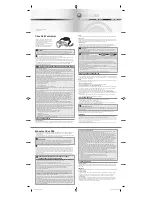
Page 13
brown in the case of 24VDC motors and invert the two wires marked black and brown for
230VAC motors.
WARNING: after every limit switch or electronic protection device function the
rack will back track for around 2 mm in the opposite direction. This is quite
normal, and has been designed to release tension on mechanical parts and
allow complete weather proofing to enhance durability of mechanical parts.
10. Limit switches
10.1.
Stroke-end at opening and closure
The limit switch at opening / closure is automatic, electronically operated and cannot be
programmed. The actuator stops when the charge is absorbed when the window is
completely open / closed, or when the charge absorbed is more than 10% of the nominal
charge. In this case, at maximum charge the actuator exercises a traction force of over
660N.
10.2.
Stroke adjustment where required
Factory settings for track lengths can be shortened to regulate how much of the rod
protrudes. This operation must be carried out at the workbench with proper equipment
by technical personnel qualified to operate with maximum care and safety.
Procedure:
1. Remove the four screws on the front head of the SKY650 actuator.
2. Extract the head and rod from the body of the actuator.
3. Unscrew the two screws locking the two limit switch block pieces.
4. Move the rubber stopper and block to the required position.
5. Screw the two screws used for fixing the block into position back in again.
6. Re mount everything back onto the body of the actuator.
7. Screw in the four screws on the front head and check the settings for the new track
run.
11. Checking for correct assembly
Check that the frame has closed completely, even at the corners, and check
there are no obstacles caused by assembly in the wrong position.
Make sure the actuator is aligned with the axis of the window at 90° to the
window itself, otherwise the rack will exert incorrect pressure on the rod and
consume more voltage.
Check the lead is not too tight, as this could damage the actuator during
rotation, opening and closing of the window.
Check all screws and nuts have been properly tightened.
Page 14
12. Emergency manoeuvres, maintenance and cleaning
Should the window have to be opened manually in the event of no electricity, mechanical
failure, or for normal maintenance or cleaning of the external surface of the window frame,
the following instructions should be followed:
1. Unscrew the nut from the pin screw fixing the eyebolt head to the front shaft.
2. Hold the window with one hand and use the other hand to remove the pin screw
(this operation should be performed with the window open at least 10 cm to make
it easier to remove the screw).
3. Manually open the window.
A
TTENTION
:
RISK OF THE WINDOW FALLING OUT
;
THE SASH IS IN DANGER OF
FALLING OUT AS IT IS NO LONGER HELD IN PLACE BY THE RACK
.
4. After maintenance and/or cleaning operations are complete, repeat points 1 and
2 in reverse order.
In the event in which the cable of feeding it is damaged, to make to replace it from the
constructor or a qualified technician.
13. Troubleshooting
Please consult the following table for any eventual problems with function during
installation or normal use:
Problem
Possible cause
Solution
•
Gear motor does not
work.
•
No electricity at source.
•
Lead not connected, or
one of the wires has come
loose.
•
Check trip switch and
safety switch.
•
Check all electrical
connections on gear motor.
14. Environmental protection
All materials used in the manufacture of this appliance are recyclable.
We recommend that the device itself, and any accessories, packaging, etc. be
sent to a centre for ecological recycling as established from laws in force on
recycling.
The device is mainly made from the following materials: aluminium, zinc, iron,
plastic of various type, cuprum. Dispose materials in conformity with local
regulations about removal.
15. Certificate of guarantee
The manufacturer will guarantee good function of the appliance. The manufacturer
shall undertake to replace defective parts due to poor quality materials or
manufacturing defects in accordance with article 1490 of the Civil Code.
The guarantee covers products and individual parts for 2 years from the date
of purchase. The latter is valid as long as the purchaser possesses proof of
purchase and completion of all agreed conditions of payment.
Guarantee of good function of appliances agreed by the manufacturer implies


























